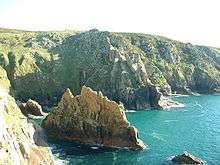A. W. Andrews
| Full name | Arthur Westlake Andrews |
|---|---|
| Country (sports) |
|
| Born |
12 December 1868 Hastings, England |
| Died |
22 November 1959 (aged 90) Zennor, England |
| Singles | |
| Grand Slam Singles results | |
| Wimbledon | 3R (1909) |
| Doubles | |
| Grand Slam Doubles results | |
| Wimbledon | 3R (1909)[1] |

Arthur Westlake Andrews (12 December 1868 – 22 November 1959) was a British geographer, poet, rock-climber, mountaineer and amateur tennis and badminton player.
He trained as a geographer (FRGS 1896) and became a teacher of geography and history in Southwark. In 1913 he published "a text-book of geography", reprinted in 1922.
As a climber, his first contribution appears to have been, in 1899, the route now called 'Andrews' renne' on Storen, Norway.
He is especially remembered for two later climbing contributions: for his co-authorship, with J. M. A. Thomson in 1909 of the first rock-climbing guide-book, to the cliffs of Lliwedd, in Snowdonia; and for being the 'father' of Cornish sea cliff climbing, beginning with an early ascent (1902) of the Bosigran Ridge Climb (aka Commando Ridge grid reference SW413368) followed by Ledge Climb (also Bosigran) in 1905. With E. C. Pyatt he later produced the first official (Climbers' Club) Cornish climbing guide, in 1950.
He is also believed (ref 1) to have had a project to traverse all the British coastline, between the high and low water marks, aided where necessary by a rope, starting in Cornwall.
In later years he appears to have turned to poetry inspired by the scenery of West Penwith, Cornwall.
Coordinates: 50°10′29″N 5°37′28″W / 50.17462°N 5.62456°W
References
Ref 1. O'Sullivan, Pete (1984) West Penwith (2nd edition), Climbers Club, ISBN 0-901601-28-4
Ref. 2 Climbers Club Journal, 1997